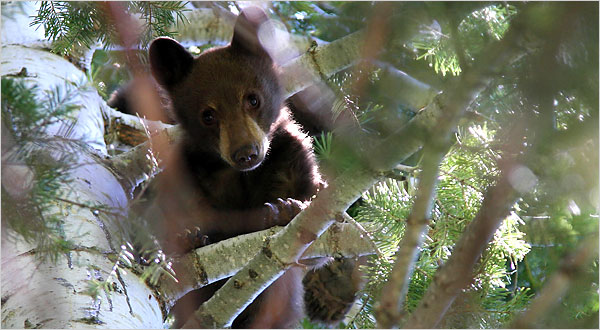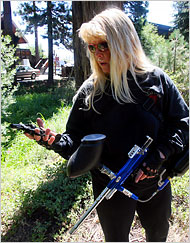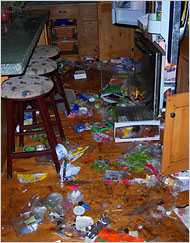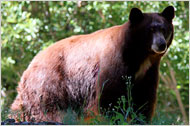Hungry Bears Are Lured by the Well-Stocked Home |
|
 |
|
| Black bears in the Lake Tahoe area, locked out of garbage by metal boxes, are breaking into homes for food. | |
| By CAROL POGASH Published: August 2, 2007 |
|
TAHOE CITY, Calif. — In the 17 years the Hyde family has lived at the edge of a national forest, bears have broken into their garage three times, but nothing prepared them for what they found in July after returning from five days of wilderness camping. |
|
| The front window of their sturdy mountain home had been smashed, and when Danny Hyde, a school principal, opened the front door, he discovered that a bear and two cubs had taken up residence. They were still inside, having ripped out cupboards, emptied the refrigerator and feasted on molasses, Fig Newtons, Thin Mints, Cool Whip, ice cream, honey and chicken chow mein. After Mr. Hyde yelled, they bolted out an open window. It took seven people five hours to shovel out the mess. | |
 * Enlarge This Image * |
The Lake Tahoe area is experiencing a rise in home invasions by bears. Years of humans’ feeding bears and available garbage have urbanized black bears, and a drought last winter has aggravated the problem. And some people fear that one of the measures intended to fend off the bears has actually helped increase the break-ins. Ann Bryant, executive director of the BEAR League, which promotes human-bear co-existence, estimates there are five bear break-ins around Lake Tahoe every night. Jason Holley, a wildlife biologist with the California Department of Fish and Game, believes the number is twice that. |
 |
Bear home invasions have become so common that the local newspaper runs a weekly report by Ms. Bryant. She tries to modify the behavior of bears and humans but says bears are easier to retrain than humans. She urges residents to remove food from vacant houses and install double locks, double window panes, shutters, barking-dog alarms and metal containers, or bear boxes, with keys to secure garbage. Ms. Bryant helped push through legislation requiring bear boxes on new construction. Others suggest that the boxes are part of the problem. “We didn’t hardly have any break-ins before we had the boxes,” said Deputy Sheriff John Lasagna of Placer County. |
“Bear-proofing trash is the right thing to do, but it can cause problems in the short term as bears try to find ways to replace those missing calories,” said Linda Masterson, author of “Living with Bears: A Practical Guide to Bear Country” (PixyJack Press, 2006). There are 250 to 500 bears around Tahoe, and everyone seems to have a bear story. Last year bears stole a prize-winning gingerbread house from a refrigerator at a local resort. When a bear broke into the home of Marvis Stoecker several years ago, it licked clean huge jars of peanut butter and mayonnaise but dumped the pickled okra. Ms. Bryant recalls one morning feeling a nudge on her elbow while stirring oatmeal. A bear wanted breakfast. Adult black bears can weigh as much as 400 pounds, and while many have lost their fear of humans, they are capable of inflicting harm. Some bears in the Tahoe area now forgo winter dozing in favor of daily dining made possible by human habitation. Rather than losing weight in winter, some gain and give birth to more offspring than in the wild, said Carl Lackey, a biologist who specializes in black bears for the Nevada Department of Wildlife. Mr. Lackey has studied Tahoe bears for 10 years. In late July, bears returned to Ward Creek where the Hydes live, punching out the door of a large house and nabbing chicken patties, hot dogs and vanilla ice cream. At an older house with wooden bars on windows and a radio blasting, they plowed through the front door, leaving a calling card on the front stoop: a licked-clean container of Pillsbury chocolate frosting. At a third house with a bear carved into a wooden welcome sign, they clawed through a particle-board door and electrical wires, littering the property with discarded wrappers from M&Ms and other candies. With the increase in break-ins, at least three neighborhood families plan to give up their vacations to defend their homes. One July morning Ms. Bryant, who is not paid for her work with bears, spent time coaxing a 65-pound cub to leave its habitat behind Starbucks. She shot it with nontoxic paintballs and blanks from a starter pistol and hollered until it fled. Then she dashed to the Hydes’ neighborhood where she was joined by Sheriff Lasagna armed with a shotgun and rubber ball bullets. Tromping through the woods, Ms. Bryant fired her starter pistol eight times. If the bears kept returning, she feared that they would have to be killed. Sheriff Lasagna took off after the mother bear although both he and Ms. Bryant knew it would return. The bear’s cubs were high up in a conifer hard by one of the houses they had raided. Ms. Bryant bemoaned the fact that a mother bear was teaching her cubs that this was the way to forage. Once a bear becomes a nuisance, California residents can request a depredation permit to have it killed, although that creates new risks. Recently one homeowner found his bear trap sabotaged and signs posted with his name, phone number and the appellation “bear killer.” “I feel violated. There’s a predator out there who wants something I have,” said Mr. Hyde, who admits he feels conflicted. “Nobody wants a depredation permit because of the residual community reaction.” His wife, Catherine, said, “There’s no good solution.” After Ms. Bryant had given up for the day, neighbors screwed thick plywood to the gaping hole in the particle-board door where bears had swiped M&Ms and other sweets. By morning there was a hole in the new plywood. The refrigerator door was ajar. The bears had returned. online at: http://www.nytimes.com/2007/08/02/us/02bears.html |
|
